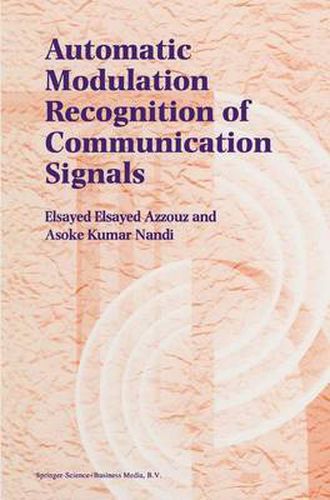Readings Newsletter
Become a Readings Member to make your shopping experience even easier.
Sign in or sign up for free!
You’re not far away from qualifying for FREE standard shipping within Australia
You’ve qualified for FREE standard shipping within Australia
The cart is loading…






This title is printed to order. This book may have been self-published. If so, we cannot guarantee the quality of the content. In the main most books will have gone through the editing process however some may not. We therefore suggest that you be aware of this before ordering this book. If in doubt check either the author or publisher’s details as we are unable to accept any returns unless they are faulty. Please contact us if you have any questions.
Automatic modulation recognition is a rapidly evolving area of signal analysis. In recent years, interest from the academic and military research institutes has focused around the research and development of modulation recognition algorithms. Any communication intelligence (COMINT) system comprises three main blocks: receiver front-end, modulation recogniser and output stage. Considerable work has been done in the area of receiver front-ends. The work at the output stage is concerned with information extraction, recording and exploitation and begins with signal demodulation, that requires accurate knowledge about the signal modulation type. There are, however, two main reasons for knowing the current modulation type of a signal; to preserve the signal information content and to decide upon the suitable counter action, such as jamming. Automatic Modulation Recognition of Communications Signals describes in depth this modulation recognition process. Drawing on several years of research, the authors provide a critical review of automatic modulation recognition. This includes techniques for recognising digitally modulated signals. The book also gives comprehensive treatment of using artificial neural networks for recognising modulation types. Automatic Modulation Recognition of Communications Signals is the first comprehensive book on automatic modulation recognition. It is essential reading for researchers and practising engineers in the field. It is also a valuable text for an advanced course on the subject.
$9.00 standard shipping within Australia
FREE standard shipping within Australia for orders over $100.00
Express & International shipping calculated at checkout
This title is printed to order. This book may have been self-published. If so, we cannot guarantee the quality of the content. In the main most books will have gone through the editing process however some may not. We therefore suggest that you be aware of this before ordering this book. If in doubt check either the author or publisher’s details as we are unable to accept any returns unless they are faulty. Please contact us if you have any questions.
Automatic modulation recognition is a rapidly evolving area of signal analysis. In recent years, interest from the academic and military research institutes has focused around the research and development of modulation recognition algorithms. Any communication intelligence (COMINT) system comprises three main blocks: receiver front-end, modulation recogniser and output stage. Considerable work has been done in the area of receiver front-ends. The work at the output stage is concerned with information extraction, recording and exploitation and begins with signal demodulation, that requires accurate knowledge about the signal modulation type. There are, however, two main reasons for knowing the current modulation type of a signal; to preserve the signal information content and to decide upon the suitable counter action, such as jamming. Automatic Modulation Recognition of Communications Signals describes in depth this modulation recognition process. Drawing on several years of research, the authors provide a critical review of automatic modulation recognition. This includes techniques for recognising digitally modulated signals. The book also gives comprehensive treatment of using artificial neural networks for recognising modulation types. Automatic Modulation Recognition of Communications Signals is the first comprehensive book on automatic modulation recognition. It is essential reading for researchers and practising engineers in the field. It is also a valuable text for an advanced course on the subject.